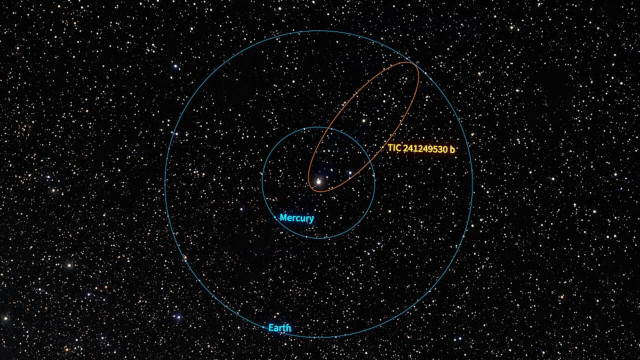
An article published in the journal “Nature” reports a study on the exoplanet cataloged as TIC 241249530 b which labels it as a progenitor of a hot Jupiter. A team of researchers used various telescopes to study TIC 241249530 b and try to understand its characteristics and evolution. This gas giant has an extremely eccentric orbit, meaning it’s extremely elongated, which could change greatly as time passes.
Observations and simulations suggest that the star’s gravitational action will drive this planet to have an almost circular orbit close to the star itself. This led the researchers to conclude that TIC 241249530 b is in the first phase of a planetary migration. The star is slightly more massive than the Sun and has an age estimated at just over three billion years, which indicates that these processes can begin well after the formation of a planetary system.
A few hundred exoplanets of the hot Jupiter class are known. These gas giants very close to their stars are heated considerably, increasing their volume. Astronomers think they didn’t form in that area because a star absorbs all or almost all the gas in its vicinity. This means that these planets must have formed further away and then moved closer to their star but the migration mechanisms are not yet clear. The exoplanet TIC 241249530 b could offer some clues.
The only precedent is the exoplanet HD 80606, discovered in 2001. It’s another gas giant with a very eccentric orbit, perhaps due to the fact that it’s located in a binary system. TIC 241249530 b was discovered in 2020 using NASA’s TESS space telescope, and its orbit was found to be even more elongated.
The existence of TIC 241249530 b was confirmed using the NN-EXPLORE Exoplanet and Stellar Speckle Imager (NESSI) and NN-EXPLORE Exoplanet Investigations with Doppler Spectroscopy (NEID) instruments mounted on the WIYN 3.5-meter Telescope and the Kitt Peak National Observatory (KPNO). More information was added later using other astronomical instruments.
The information obtained allowed to estimate that the mass of the exoplanet TIC 241249530 b is approximately five times Jupiter’s. The reconstruction of its orbit, illustrated in the bottom image (NOIRLab/NSF/AURA/R. Proctor), indicates that it’s the most eccentric known so far for a planet: if it were in the solar system, it would go well inside the orbit of Mercury and then it would cross the orbit of the Earth.
The strange orbit of TIC 241249530 b leads to notable temperature excursions on its surface estimated at the minimum ones comparable to a normal Earth summer and the maximum ones sufficient to melt titanium. As if this weren’t enough, that orbit is retrograde, and this means that it goes in the opposite direction to its star’s rotation. The cause isn’t certain but it could be another case of an influence from a second, nearby star.
The researchers conducted simulations to try to understand how the orbit of the exoplanet TIC 241249530 b will evolve and believe that its star’s gravitational action will transform it into a hot Jupiter. In essence, its orbit will become more and more circular, reducing its distance until it becomes almost circular and very close to the star.
For several years, the exoplanet HD 80606 was the only example of a possible hot Jupiter progenitor. Now TIC 241249530 b confirms the existence of gas giants with very eccentric orbits but who knows how many millennia it will take to verify their transformation. In the meantime, research continues, also of potential progenitors that are not part of binary systems to understand if interactions between different planets can also have strong influences on their orbits.


